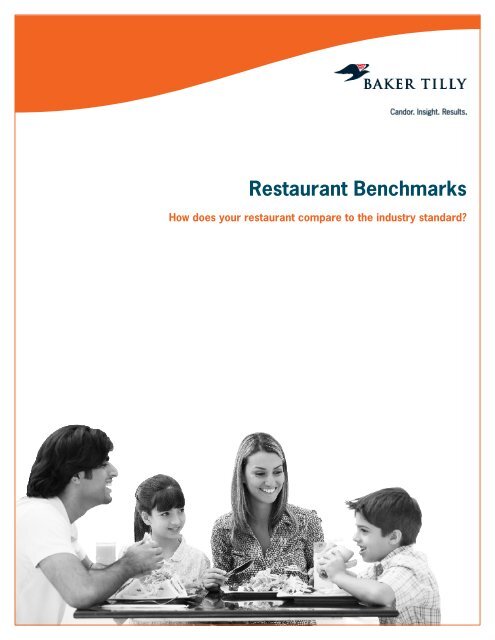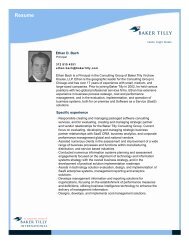Restaurant Benchmarks - Baker Tilly
Restaurant Benchmarks - Baker Tilly
Restaurant Benchmarks - Baker Tilly
Create successful ePaper yourself
Turn your PDF publications into a flip-book with our unique Google optimized e-Paper software.
<strong>Restaurant</strong> <strong>Benchmarks</strong><br />
How does your restaurant compare to the industry standard?
<strong>Restaurant</strong> Methods, Procedures, and Measurements<br />
Knowing industry benchmarks is critically important to today’s restaurant owner. Keep this reference handy when analyzing your restaurant<br />
performance. Below is a summary of the general restaurant standards. These rules of thumb are discussed in more detail following the<br />
summary in order to assist with the assessment. <strong>Baker</strong> <strong>Tilly</strong> understands that each restaurant is unique and that not every guideline will relate<br />
to every business. For help in determining which benchmarks are appropriate for you, please contact your <strong>Baker</strong> <strong>Tilly</strong> advisor.<br />
Summary of Industry Standards<br />
Prime Cost<br />
> Full-service - 65% or less of total sales<br />
> Table-service - 60% or less of total sales<br />
Food Cost<br />
> Generally - 28% to 32% of total food sales<br />
Alcoholic Beverage Costs<br />
> Liquor - 18% to 20% of liquor sales<br />
> Bar consumables - 4% to 5% of liquor sales<br />
> Bottled beer - 24% to 28% of bottled beer sales<br />
> Draft beer - 15% to 18% of draft beer sales<br />
> Wine - 35% to 45% of wine sales<br />
Nonalcoholic Beverage Costs<br />
> Soft drinks (post-mix) - 10% to 15% of soft drink sales<br />
> Regular coffee - 15% to 20% of regular coffee sales<br />
> Specialty coffee - 12% to 18% of specialty coffee sales<br />
> Iced tea - 5% to 10% of iced tea sales<br />
Paper Cost<br />
> Full-service - 1% to 2% of total sales<br />
> Limited-service - 3% to 4% of total sales<br />
Payroll Cost<br />
> Full-service - 30% to 35% of total sales<br />
> Limited-service - 25% to 30% of total sales<br />
Information provided by Jim Laube, founder of www.<strong>Restaurant</strong>Owner.com.<br />
Profitability Standards<br />
Sales per square foot is the most reliable indicator of a restaurant’s<br />
potential for profit. To calculate sales per square foot, divide annual<br />
sales by the total interior square footage including kitchen, dining,<br />
storage, rest rooms, etc. This is usually equal to the net rentable<br />
square feet in a leased space.<br />
Sales Per Square Foot = Annual Sales/Square Foot<br />
Full-service<br />
Under $150/square foot = little chance of generating a profit<br />
At $150 to $250/square foot = break even up to 5% of sales<br />
At $250 to $325/square foot = 5% to 10% of sales<br />
Limited-service<br />
Under $200/square foot = little chance of averting an operating loss<br />
At $200 to $300/square foot = break even up to 5% of sales<br />
At $300 to $400/square foot = 5% to 10% of sales (before income<br />
taxes)<br />
Management Salaries<br />
> 10% or less of total sales<br />
Hourly Employee Gross Payroll<br />
> Full-service - 18% to 20% of total sales<br />
> Limited-service - 15% to 18% of total sales<br />
Employee Benefits<br />
> 5% to 6% of total sales<br />
> 20% to 23% of gross payroll<br />
Sales Per Square Foot<br />
> Losing Money Full-service - $150 or less<br />
Limited-service - $200 or less<br />
> Break-even Full-service - $150 to $250<br />
Limited-service - $200 to $300<br />
> Moderate Profit Full-service - $250 to $350<br />
Limited-service - $300 to $400<br />
> High Profit Full-service - More than $350<br />
Limited-service - More than $400<br />
Rent and Occupancy<br />
> Rent - 6% or less of total sales<br />
> Occupancy - 10% or less of total sales<br />
Rent and Occupancy Cost Standards<br />
Rent = 6% or less<br />
Generally, the goal is to limit rent expense to 6% of sales or less,<br />
exclusive of related costs such as common area maintenance (CAM)<br />
and other occupancy expenses.<br />
Occupancy = 10% or less<br />
Occupancy cost includes rent, CAM, insurance on building and<br />
contents, real estate taxes, personal property taxes, and other<br />
municipal taxes. Many operators want to keep occupancy cost at or<br />
below 8% of sales, however, 10% is generally viewed to be the point<br />
at which occupancy cost starts to become excessive and begins to<br />
seriously impair a restaurant’s ability to generate an adequate profit.
Percentage of Cost Standards<br />
Food<br />
Food cost equals 28% to 32% in many full-service and limitedservice<br />
restaurants.<br />
Alcoholic Beverage<br />
Alcohol costs vary with the types of drinks served:<br />
> Liquor - 18% to 20%<br />
> Draft beer - 15% to 18%<br />
> Bar consumables - 4% to 5%<br />
> Wine - 35% to 45%<br />
> Bottled beer - 24% to 28%<br />
Nonalcoholic Beverage<br />
Standard practice is to record nonalcoholic beverages sales<br />
and costs in Food Sales and Food Costs accounts:<br />
> Soft drinks - 10% to 15%<br />
> Specialty coffee - 12% to 18%<br />
> Regular coffee - 15% to 20%<br />
> Iced tea - 5% to 10%<br />
Paper<br />
In limited-service restaurants paper cost should be classified as a separate line item in “cost of sales.” Historically, paper cost has run from<br />
3% to 4% of sales. In full-service restaurants, paper cost is usually considered to be a direct operating expense and normally runs from 1%<br />
to 2% of total sales.<br />
Payroll & Salaries<br />
Payroll cost as a percentage of sales includes the cost of both salaried and hourly employees plus employee benefits, which includes<br />
payroll taxes, group, life and disability insurance premiums, workers’ compensation insurance premiums, education expenses, employee<br />
meals, parties, transportation, and other such benefits. Total payroll cost should not exceed 30% to 35% of total sales for full-service<br />
operations, and 25% to 30% of sales for limited-service restaurants.<br />
Generally, you don’t want management salaries to exceed 10% of sales in either a full- or limited-service restaurant. This would consist of<br />
all salaried personnel.<br />
Hourly Employee Gross Payroll<br />
> Full-service - 18% to 20%<br />
> Limited-service - 15% to 18%<br />
Limited-service restaurants generally have lower hourly payroll cost percentages than full-service restaurants. In<br />
limited-service restaurants, managers often perform the work of an hourly position in addition to being a<br />
manager. In some cases, however, hourly workers may also perform management roles on some<br />
shifts, which could lead to higher hourly payroll costs in these restaurants.<br />
Employee Benefits Overview<br />
> Employee benefits 5% to 6% of total sales<br />
> Employee benefits 20% to 23% of gross payroll<br />
Prime Cost Standards<br />
Employee benefits can vary somewhat depending primarily on state unemployment tax rates<br />
and state workman’s compensation insurance rates. <strong>Restaurant</strong>s that are new or have had<br />
a large number of unemployment claims may have state unemployment tax rates that could<br />
cause their employee benefits to be higher than the standard.<br />
* All percentages shown are the ratio of each item’s cost divided by its sales (not total sales).<br />
Prime cost is one of the most telling numbers on any restaurant’s profitand-loss<br />
statement. Prime cost is arrived at by adding cost of sales<br />
and payroll costs. Prime cost reflects those costs that are generally the<br />
most volatile and deserve the most attention from a control standpoint.<br />
It’s very easy to lose money due to lax or nonexistent controls in the<br />
areas of food, beverage and payroll. Many successful restaurants<br />
calculate and evaluate their prime cost at the end of each week.<br />
> Full-service - 65% or less (total sales)<br />
> Table-service - 60% or less (total sales)<br />
When looking at a restaurant’s overall cost structure, prime cost can<br />
be very meaningful, particularly in cost of sales and payroll cost. Some<br />
restaurants, such as steak and seafood restaurants, may carry very<br />
high food cost and yet be extremely profitable.
<strong>Baker</strong> <strong>Tilly</strong> <strong>Restaurant</strong> Industry Focus<br />
About <strong>Baker</strong> <strong>Tilly</strong><br />
<strong>Baker</strong> <strong>Tilly</strong> Virchow Krause, LLP was founded in 1931 with one central objective: to use our expertise to help our clients improve their<br />
businesses. Originally a certified public accounting firm, we have grown steadily over the years, broadening our service offerings and<br />
expanding our geographic presence to meet the evolving needs of our clients. With more than 1,400 staff in nine offices across the<br />
Midwest, we are now the 16th largest public accounting firm in the United States, according to Accounting Today’s Top 100 of 2011.<br />
Our <strong>Restaurant</strong> Expertise<br />
The restaurant industry has been well established as one of the firm’s industry niches. Having a dedicated team of professionals for the<br />
restaurant industry enhances the service we are able to provide you. Enabling us to understand your industry and the issues you face,<br />
resulting in proactive, accurate, and efficient service. We spend more time addressing your business needs and less time learning the<br />
industry. Our team attends and sponsors finance conferences specifically for the restaurant industry. We have participated on national panel<br />
discussions for restaurant CFOs and have been published in <strong>Restaurant</strong> Finance Monitor.<br />
If you have any questions or would like to learn more about our restaurant service team please contact:<br />
Todd Bernhardt<br />
Partner, CPA<br />
608 240 2654<br />
todd.bernhardt@bakertilly.com<br />
Darlene Middleman<br />
Senior Manager, CPA<br />
414 777 5352<br />
darlene.middleman@bakertilly.com<br />
Chuck Droege<br />
Partner, CPA<br />
312 729 8008<br />
charles.droege@bakertilly.com<br />
Mary Voss<br />
Manager, CPA<br />
920 739 3414<br />
mary.voss@bakertilly.com<br />
<strong>Baker</strong> <strong>Tilly</strong> Virchow Krause, LLP<br />
bakertilly.com<br />
Published by <strong>Baker</strong> <strong>Tilly</strong> Virchow Krause, LLP as a source of information for clients and business associates. Since technical information is presented in generalized<br />
form, professional advice should be obtained before implementing specific ideas. No reproduction of this publication may be made without the permission of <strong>Baker</strong><br />
<strong>Tilly</strong> Virchow Krause, LLP.<br />
Pursuant to the rules of professional conduct set forth in Circular 230, as promulgated by the United States Department of Treasury, nothing contained in this<br />
communication was intended or written to be used by any taxpayer for the purpose of avoiding penalties that may be imposed on the taxpayer by the Internal Revenue<br />
Service, and it cannot be used by any taxpayer for such purpose. No one, without our express prior written permission, may use or refer to any tax advice in this<br />
communication in promoting, marketing, or recommending a partnership or other entity, investment plan or arrangement to any other party.<br />
<strong>Baker</strong> <strong>Tilly</strong> refers to <strong>Baker</strong> <strong>Tilly</strong> Virchow Krause, LLP, an independently owned and managed member of <strong>Baker</strong> <strong>Tilly</strong> International. The information provided here is of a general nature and is not intended to address the<br />
specific circumstances of any individual or entity. In specific circumstances, the services of a professional should be sought. © 2012 <strong>Baker</strong> <strong>Tilly</strong> Virchow Krause, LLP






